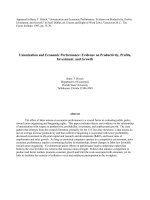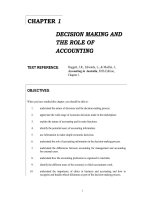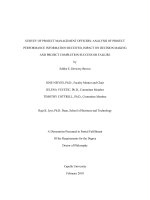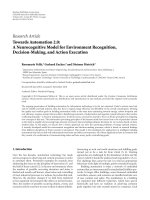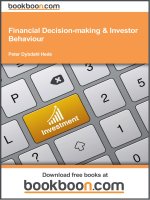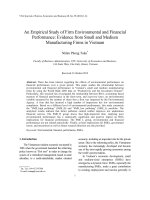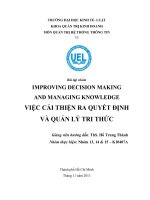Heuristics influencing investment decision making and investment performance evidence from individual investors in vietnam
Bạn đang xem bản rút gọn của tài liệu. Xem và tải ngay bản đầy đủ của tài liệu tại đây (1.36 MB, 80 trang )
Master Thesis
Heuristics influencing decision making
and performance: evidence from
individual investors in Vietnam
Nguyen Thi Thanh Thuy
Mbus 3.2
Supervisor: Dr. Tran Phuong Thao
DECLARATION
I hereby declare that this thesis, to the best of my knowledge and belief, is my own
work and effort and that is has not been submitted, either in part or whole, anywhere for
any award.
Information and ideas taken from other sources as cited as such. This work has not
been published.
ACKNOWLEDGE
This research would not have been possible without the valuable contribution
of many people. We would like to take this chance to express my great gratitude
for their understanding, encouragement, and supports.
Firstly, I would like to my deepest appreciation to my thesis supervisor, Dr.
Tran Phuong Thao, for numerous valuable comments and suggestions. I am very lucky
to have her supervision as her continuous encouragement has motivated me and made me
confident to finish this research.
Then, I would like to thank the faculty of International School of Business (ISB) –
University of Economic Ho Chi Minh City. I would also like to show my gratitude to
Professor Nguyen Dinh Tho for his patient in listening, discussing, and giving
me
precious recommendations. I am especially indebted to him for his indispensable
guidelines with regard to statistical analysis techniques.
A special appreciation to my friends and colleagues for giving me the sound
comments on my questionnaire as well as instant support regardless day or night. This
helps me a lot in improving the quality of the research.
Furthermore, we want to express our gratefulness to my friends working at the Ho
Chi Minh Stock Exchange and securities companies, who help me to arrange interviews
and distribute questionnaires. I am also thankful to beneficiary customers who participated
in and the survey.
Finally, it would be impossible to say enough about my dear parents, my
respectable teachers at University of Economics Ho Chi Minh City and my loved friends.
All their understanding, encouragement, and advices help me to overcome the most
difficult time to complete this research in time.
Ho Chi Minh City, June 6th, 2015
Nguyen Thi Thanh Thuy
LIST OF FIGURES
Figure 2.1 Research model ......................................................................................... 17
Figure 3.1 Research process ....................................................................................... 20
Figure 3.2 New research model (revised)................................................................... 27
LIST OF TABLES
Table 3.1 Types of measurement for heuristic variables influencing investment decision
making ........................................................................................................................ 22
Table 3.2 Types of measurement for individual investors’ decision making ............ 23
Table 3.3 Types of measurement for individual investors’ performance................... 24
Table 4.1 Descriptive statistic of respondent’s characteristics................................... 31
Table 4.2 Reliability analysis for each factor ............................................................. 35
Table 4.3 Key dimensions, items ............................................................................... 37
Table 4.4 Correlation among factors .......................................................................... 38
Table 4.5 Regression analysis - Model summary....................................................... 39
Table 4.6 ANOVA ...................................................................................................... 40
Table 4.7 Regression analysis of variables................................................................. 41
Table 4.8 Correlation .................................................................................................. 42
Table 4.9 Regression analysis – Model summary ...................................................... 43
Table 4.10 ANOVA .................................................................................................... 44
Table 4.11 Regression analysis of variables............................................................... 44
Table 5.1 Conclusion .................................................................................................. 49
ABSTRACT
The main objective of this study is to investigate the heuristic factors influencing
individual investors’ decisions and investment performance at the Ho Chi Minh Stock
Exchange. As there are limited studies about behavioral finance in Vietnam, this
study is expected to contribute significantly to the development of this field in Vietnam.
The study begins with the existing theories in behavioral finance, based on
which, hypotheses are proposed. Then, these hypotheses are tested through the
questionnaires distributed to individual investors at the Ho Chi Minh Stock Exchange.
The result shows that there is only overconfidence bias affecting the investment
decisions of individual investors at the Ho Chi Minh Stock Exchange among three
factors of heuristic (including available bias, representativeness bias and overconfidence
bias). Moreover, this study also found out the relationship between decision making
of individual investors and investment performance.
Keywords:
Heuristic,
performance, Vietnam.
individual
investor, decision making, investment
CHATER 1: INTRODUCTION
1.1 Background
In the financial markets, investment decisions are commonly made by individual
investors and fund managers. Their investment decisions are often supported by decision
tools such as fundamental analysis, technical analysis and judgment. It is assumed that
information structure and behavioral factors in the market systematically influence
individuals’ investment decisions as well as market outcomes (Mutswenje, 2014).
However, in reality, investor behaviors are often derived from psychological principles
of decision making to explain why people buy or sell stocks. These factors that are
normally known as behavioral factors focused upon how investors interpret and act on
information to make investment decisions.
Much of the economic and financial theories presume that individuals act rationally
in the process of decision making, by taking into account all available information. But
there is evidence to show repeated patterns of irrationality in the way humans arrive at
decisions and choices when faced with uncertainty (Bernstein, 1996). Behavioral finance,
a study of market that draws on psychology, throws light on why people buy or sell stock
and why sometimes do not buy or sell at all. The most crucial challenge faced by the
investors is in the area of investment decisions. The profit made, or losses incurred by an
investor can be attributed mainly to his decision-making abilities. The fact that even the
most prominent and well-educated investors were affected by the collapse of the
speculative bubble in the 2008 subprime crisis proved that something was fundamentally
missing in the traditional models of rational market behavior (Subash, 2012).
In the behavioral finance discipline, heuristics can be defined as the use of
experience and practical efforts to answer questions or to improve performance (Fromlet,
2001). Raines & Leathers (2011) argue that when faced with uncertainty, people rely on
heuristics or rules of thumb to subjectively assess risks of alternatives, which reduces the
complex tasks of assessing probabilities and predicting values to simpler judgmental
1
operations.
It could be seeing that, heuristics are quite useful in investment decision making
(Waweru et al., 2008, p.27), however they may lead to biases (Kahneman & Tversky, 1974,
p.1124; Ritter, 2003, p.431). For instance, Kahneman & Tversky (1974, page 1124)
introduce three factors belongs to heuristics namely representativeness, availability bias,
and anchoring, while Waweru et al. (2008) also list two factors named Gambler’s fallacy
and Overconfidence of heuristic .
There are several studies in the literature investigating the relationship between
heuristics and decision making and performance of individual investor as well. Tversky &
Kahneman (1974) conduct the research of judgment under uncertainty, heuristics and
biases. Hassan et. al (2013) study impacts of affect heuristics, fear and anger on the
decision making of individual investor in a conceptual study. In addition, another study
examines investment behavior and performance of various investor types in Finland’s
stock market done by Grinblatt & Keloharju, 2000.
1.2 Research problem
In the literature, many papers show that investment decision of investors may be
affected by behavioral finance. Thus, many researchers attempt to investigate
psychological and sociological factors such as heuristics that may influence investment
decisions making process of individual (Subrahmanyam 2007, Le & Doan 2011,
Kengatharan 2014).
In Vietnam, the first official stock exchange, namely the Ho Chi Minh Stock
Exchange (known as HOSE) has been launched since mid-2000 and five years later, the
Ha Noi Stock Exchange, (known as HNX) was established. Both the markets have recently
significantly developed. At the time of establishment, the Vietnamese stock market was
still strange and vague to most of local people due to several its limitations such as
insufficient legal foundation, simple trading system, very few security companies and
limited types of securities (HOSE, 2010, p.7). Recently, the Vietnamese stock market has
experienced significant development with regards to the market size and market
2
capitalization. As of November 2014, there were 345 companies listed on HOSE, with the
listed value of almost 339,000 billion VND and 367 companies listed on HNX, with the
listed value of almost 92,422 billion VND, reach over VND 145,000 billion of the total
market value. However, in comparison to foreign stock markets, Vietnam stock market
appears to be much smaller in terms of market size and market capitalization (Le & Doan,
2011).
Among the two exchanges, the Ho Chi Minh stock exchange has been developing
significantly in both a number of listed stocks and trading values; however, its aggregate
market index (VN-Index) movement seems to fluctuate unpredictably over different
periods. As such, several studies shown that investment decision making of investors,
particularly individual investors, in the market is influenced by many factors including
behavioral factors such as herding effect, heuristic and market factors (Waweru, 2008,
Hassan et al, 2013).
Several studies in the literature show that individual investors have difficulties
making investment decisions due to lack of financial sophistication (Winchester et al. 2011).
Individual investors often have embraced heuristics or rule of thumb in their investment
decision making (Shikuku, 2010). This issue may raise a concern that whether investment
decision making of individual investors in the Vietnamese stock market is influenced by
heuristic? Hence, this research attempts to investigate the influence of heuristic factors on
influencing individual investors’ decision-making and performance in the context of the
Vietnamese stock market.
1.3 Research objective and research questions
The objective of the study is to investigate impacts of heuristic factors on individual
investors’ decision-making and their investment performance. More specifically, two
questions are given as follows:
Question 1: Do heuristic factors influence individual investors’ decisions in the
Vietnamese stock market?
Question 2: Does a strong tendency of investment decision making have a
3
positive influence on the investment performance?
1.4 Scope of the research
There are several heuristic factors influencing behaviors of investors in stock
markets. In this study, three heuristic factors are taken into account, namely
representativeness, availability and overconfidence. There are factors that mentioned in
several studies such as the research on overconfidence bias (Glaser and Weber, 2012), the
study on representativeness bias (Taffler, 2012) and analysis regarding to the effects of
behavioral factors on investment decision making by unit companies in Kenya (Shikuku,
2010) and so on.
In this thesis, individual investors are concerned because according to the report of
the Wall Street Securities (2014) this group of investors account for over 60 percentages
of investors trading in the Vietnamese stock market.
In addition, due to the time constraint, the research focuses only on the heuristic
behaviors of individual investors studying or working at the Ho Chi Minh City only. The
Ho Chi Minh City is chosen because it is often considered as the biggest economic center
of Vietnam and the biggest Vietnamese stock exchange, namely the Ho Chi Minh Stock
Exchange, is located there.
1.5 Structure of the thesis
This thesis is organizes in five chapters as follow:
Chapter 1 is an introduction chapter. This chapter describes an overview of research
background, research problem, and objective. Besides, the scope of research,
implications, and structure of thesis are also present.
Chapter 2 is about presenting previous research done on the stream of studies
related to theoretical foundation regarding to explain prospect theory and heuristics
theory as well. Besides, heuristics of individual investors also is presented in detail in the
research. More importantly, investment decision making and investment performance of
individual investors is clearly explored as well. This chapter is to concentrate on
4
explaining each variable in the model, and reasons for choosing them to be included in
the research model.
Chapter 3 is research methodology chapter. Firstly, research process is presented
in general. Then, research design and sampling are also mentioned regarding to
qualitative method and quantitative method as well. After that, the measurement scales
apply for the research factors will be determined clearly and suitably. This chapter also
defines how to collect data and analyze the data collected to test the research hypotheses
proposed in chapter 2. Finally, research method is explained in detail regarding to
Cronbach alpha, Exploratory Factor Analysis and Multiple regression analysis.
Chapter 4 is the analysis and discussion chapter. In detail, data background is firstly
mentioned and measurement reliability of each factor using Cronbach’s alpha is properly
presented as well. Moreover, scale testing by using Exploratory Factor Analysis and
multiple regression analysis is explored in detail in the session. Furthermore, this part
also discusses the method for collecting data used to test the hypothesis, and it analyses
the data received, its reliability and multiple regression as well.
The last chapter, chapter 5 discusses the results and research findings. This chapter
gives conclusion, implication, and research limitations. Finally, this thesis makes
suggestions for further research on the topic area.
5
CHAPTER 2: LITERATURE REVIEW, HYPOTHESIS AND
RESEARCH MODEL
This chapter reviews the related literatures of behavioral finance regarding to
heuristic factors that is mentioned as a main content of the study. Firstly, some backgrounds
of behavioral finance and the important theories of behavioral finance such as prospect
theory and heuristics theory are included to have an overall picture of this field and its
impacts on the investment decisions and performance. Next, heuristic of individual investors
is presented in detail like definition of heuristics and the prior studies on heuristics as well as
its classification are also explored deeply and its impact to the investment decisions and
performance. More importantly, the content of investment decision making and investment
performance is properly discussed as major subject. Finally, a research model with hypotheses
is proposed to follow during the research.
2.1 Theoritical foundation
2.1.1 Prospect theory
Prospect theory is the behavioral theory that has the most remarkable impact on
economic research (Okur & Gurbuz, 2014). This theory was developed by Professor Daniel
Kahneman and Amos Tversky in 1979. Starting from empirical evidence, it described how
individuals evaluate losses and gains. Kahneman & Tversky (1979) developed this theory
to remedy the descriptive failures of expected utility theory of decision making. Prospect
theory attempted to describe decisions under uncertainty, and has also been applied to the
field of social psychology (Okur & Gurbuz, 2014). The authors argued that investors value
gains or losses according to an S-shaped utility function. In other words, prospect theory
described some states of mind affecting an individual’s
decision-making
processes
including Regret aversion, Loss aversion and Mental accounting.
In the theory, the reference point was determined by each individual as a point of
comparison. For wealth levels under the reference point investors are risk seekers that
means they are prepared to make riskier bets in order to stay above their preferred target
level of wealth. Whereas for wealth levels above this reference point, the value function
6
is down ward sloping in line with conventional theories and investors are risks averse.
Kahneman & Tversky asserted that people are risk lovers for losses as discussed in the study
by Finucane et al. (2002). As such, the utility function is concave for gains meaning that
people feel good when they gain, but twice the gain does not make them feel twice as good.
The utility function is convex for loss meaning that people experience pain when they lose,
but twice the loss does not mean twice the pain.
The theory was used to get an overall review about behaviors of individual investors
in investment decision making that includes heuristic factors. According to Okur & Gurbuz
(2014) reviewing prospect theory in finance, positing that expected utility theory, with its
rational expectations derivative, was still the dominant paradigm for investor decisions in
finance and for economic decisions in general.
2.1.2 Heuristics theory
According to Bramson (2007) heuristics is considered as a normative decision theory.
Heuristics are defined as the rules of thumb, which makes decision making easier, especially
in complex and uncertain environments by reducing the complexity of assessing probabilities
and predicting values to simpler judgments (Kahneman & Tversky, 1974, p.1124). In
general, these heuristics are quite useful, particularly when time is limited (Waweru et al.,
2008, p.27), but sometimes they lead to biases (Kahneman & Tversky, 1974, p.1124; Ritter,
2003, p.431).
Balota et al. (2004) said that many decisions are based on beliefs concerning the
likelihood of uncertain events such as the outcome of an election, the guilt of a defendant, or
the future value of the dollar. These beliefs are usually expressed in statements such as “I
think that …,” “chances are …,” “it is unlikely that …,” and so forth. Occasionally, beliefs
concerning uncertain events are expressed in numerical form as odds or subjective
probabilities. What determines such beliefs? How do people assess the probability of an
uncertain quantity? People rely on a limited number of heuristic principles which reduce the
complex tasks of assessing probabilities and predicting values to simpler judgmental
operations.
Selden (1912) said that psychology of the stock market that the ups and downs of
7
prices in stock exchanges depend upon a very substantial degree of psychological approach
of investing and trading community. According to Finucane, et al (2000), there is a negative
relationship between risk and benefits perception due to affect heuristic.
It could be seeing that an investor always wants high returns against his investment
but his or her decisions are explicitly affected by affect heuristic. Hot stocks where an
investor perceives high risk may be neglected by investor regardless of its return due to
inverse relation of affect heuristic and “judgment and decision making”. People already had
some images and symbols in their minds to perceive their risk and benefits and ultimately
they used those images and symbols to make their financial decisions in the stock market. It
is observed that there are also some investors trading in the stock market who are illiterate
and have no sufficient financial educational background so that they are unable to do detail
financial analysis before taking any decision and use heuristics to get rid of that critical
decisional phase (Hassan, 2013).
In summary, the theory is properly applied to explore possible effects of heuristic on
the individual investor’s judgments and investment decisions.
2.2 Heuristic of individual investors
2.2.1 Definition of heuristics
Heuristics, which expresses that individuals have tendency to make judgments
quickly, are simplifying strategies used to approach complex problems and limit
explanatory information (Shikuku, 2010). Individual investors tend to make decisions
usually by trial and error method thus developing rules of thumb. To put it simply, investors
use rules of thumb in order to process complex information so as to make investment
decisions. Sometimes it may lead to a favorable decision, but sometimes, it may result in
unfavorable and poor decision outcomes (Chandra, 2008). An example of a heuristic is to
judge the frequency or probability of an event by its availability, the ease with which
examples of the event come to mind. According to Finucane et al. (2000), the affect heuristic
refers to the way in which subjective impressions of “goodness” or “badness” can act as a
heuristic capable of producing fast perceptual judgments and also systematic biases. For
8
example, as Ganzach (2001) showed, people judge stocks that they perceive as “good” to
have low risks and high returns and judge stocks that they perceive as “bad” to have low
returns and high risks. Specifically, for unfamiliar stocks, perceived risk and perceived
return are negatively correlated, as predicted by the affect heuristic. In the meantime, for
familiar stocks, perceived risk and perceived return are positively correlated; riskier stocks
are expected to produce higher returns, as predicted by ordinary economic theory.
2.2.2 Classification of heuristics
There were many prior studies on heuristics such as Tversky & Kahneman (1974),
Hassan et al. (2013), Bramson (2007). Tversky & Kahneman (1982a), for instance, argue
for the prevalence of three general-purpose heuristics: representativeness, availability, and
anchoring and adjustment. Later et al. (2002) bring together the work of many other
researchers and explicitly include emotional factors as a general-purpose heuristic under the
term the affect heuristic. Gilovich and Griffin (2002) listed six general-purpose heuristics:
affect, availability, causality, fluency, similarity, and surprise.
Kahneman & Tversky (1974, p.1124-1131) who were known as the first writers
studying the factors belonging to heuristics introduce
three
factors
namely
representativeness, availability bias, and anchoring. Waweru et al (2008, p.27) also listed
two factors named Gambler’s fallacy and Overconfidence into heuristic theory. According
to Schwartz (1998) there is considerable evidence on general heuristics—notably
representativeness, availability, anchoring and adjustment, and affect (dealing with
emotions) but much less on the specific heuristics used in most decision-making
processes.
According to Shikuku (2010), due to the fact that the more information was, the
faster it spreaded, life for decision makers in financial markets has become more
complicated. This implies increased use of heuristics which is often a mostly inevitable
approach but not always beneficial (Fromlet, 2001). The interpretation of new information
may require heuristic decision-making rules (Finucane et al. 2002). Chandra (2008) studied
behavioral factors and their impacts on investors’ attitude towards risk and behavioral
9
decision making process. The study concluded that individual investors suffer from
heuristics such as representativeness, overconfidence and anchoring, cognitive dissonance,
greed and fear, and regret aversion and mental accounting which all influence investor’s
perception of risk and subsequently his decision making.
Due to the constraint time, this research focuses only on analyzing three of mainly
heuristic factors which including representativeness, availability and overconfidence.
Representativeness bias
Representativeness refers to the way people make subjective probability
judgments based on similarity to stereotypes (Barker & Nofsinger, 2012, p. 259).
However, recognizing the representativeness heuristic is easier than defining it. Gilovich
(1991, p.18) described the nature of the heuristic in more detail: “Representativeness is a
tendency to assess the similarity of outcomes, instances and categories on relatively
salient and even superficial features, and then to use these assessments and similarity as
a basis of judgment. People assume like goes with like.” Because representativeness is
not influenced by several factors that should affect probability judgments, the implication
is that errors in judgment sometimes result (Barker & Nofsinger, 2012, p. 259).
Representativeness may result in some biases such as people put too much weight on
recent experience and ignore the average long-term rate (Ritter, 2003, p.432).
Availability bias
Availability is the heuristic reflecting the weight given to information in place of
probability or frequency. That weighting is attributable to the ease of recall and the content
of what is recalled. Availability may be due to some recent dramatic news event. Warneryd
(2001) noted, availability could be experience-based, memory-based, or imagination-based.
Unfortunately, there is no agreement as to what constitutes different degrees of availability
or the weight that should be given to those differences in availability. One type of
recognition of the importance of availability can be observed from the behavior of a
successful mutual fund manager, who is supposed to have reflected that he tended to avoid
stocks that most analysts and managers were celebrating because he was convinced that
such “availability” increased the likelihood that the shares of those companies were
10
overvalued. The tendency of investors to focus so overwhelmingly on national rather than
international stocks, particularly until the mid-1990s, and to miss profitable opportunities
abroad, probably reflects reliance on the availability heuristic. Perhaps the main bias of
availability is due to its extreme lack of sensitivity to sample size; by its nature, information
that is dramatically available may reflect a small sample
Overconfidence bias
Overconfidence is a pervasive phenomenon and can have severe consequences.
Researchers have offered overconfidence as an explanation for wars, strikes, litigations,
entrepreneurial failures, and stock market bubbles (Camerer & Lovallo, 1999; Glaser &
Weber, 2007; Howard, 1983; Johnson, 2004; Malmendier & Tate, 2005; Neale &
Bazerman, 1985; Odean, 1999). According to Plous (1993, p. 217), “no problem in
judgment and decision making is more prevalent and more potentially catastrophic than
overconfidence.” On the contrary, when people overestimate the reliability of their
knowledge and skills, it is the manifestation of overconfidence (DeBondt & Thaler, 1995,
Hvide, 2002).
According to Barker & Nofsinger (2012), many researchers consider overconfidence
as the most prevalent judgment bias. Several studies show that overconfidence can lead to
suboptimal decisions on the part of investors, managers, and politicians. For examples,
investors and analysts are often overconfident in areas that they have knowledge (Evans,
2006, p.20). However, overconfidence is also believed to improve persistence and
determination, mental facility, and risk tolerance. It can help to promote professional
performance and enhance other’s perception of one’s abilities, which may help to achieve
faster promotion and greater investment duration (Oberlechner & Osler, 2004, p.3).
2.3 Decision making and performance of individual investor
2.3.1 Decision making
Making investment decision is even more critical and difficult in a stock market and
such decisions need better insight and understanding. Investment decision may have effect
due to psychological and behavioral factors (Evans, 2006 and Waweru et al., 2008).
Traditional finance expects investor to be rational but behavioral finance believes that
11
investors in stock markets act irrational. While making decisions in market the investors’
process available information. Their emotions, psychology, and behavioral biases lead to
systematic errors in the manner in which they process information (Pavabutr, 2002).
According to Macmillan (2000) each investment decision often involves complexity
and uncertainty. Complexity is reflected, in part, by the number of alternative courses of
action from which the decision-maker can choose. Uncertainty is inherent in all decisionmaking but particularly pertinent to the investment decision-maker where the implications
of their decisions are often very significant for the organization. Moreover, investors are
usually trying to fulfil multiple objectives in their investment decisions and therefore have
to make trade-offs between expected return and riskiness. Dean and Sharfman (1996) note
that it is unlikely that the influence of such forces eliminates the impact of choice on
decision effectiveness as it is hard to imagine a decision in which all potential choices will
be equally successful or unsuccessful.
Barber and Odean (2008) argued that attention greatly influences individual investor
purchase decisions. Investors face a huge search problem when choosing stocks to buy.
Rather than searching systematically, many investors may consider only stocks that first
catch their attention (e.g., stocks that are in the news or stocks with large price moves). This
will lead individual investors to buy attention-grabbing stocks heavily. Since most
individual investors own only a small number of stocks and only sell stocks that they own,
selling poses less of a search problem and is less sensitive to attention effects.
2.3.2 Investment performance
Personal rate of return is a person's own investment performance based on his or her
own transaction history and resulting cash flows. We attempt to shed light on the investment
performance of common stocks held directly by individual investors. Schlarbaum,
Lewellen, and Lease (1978a) analyze the aggregate common stock performance of investors
at a full-service brokerage firm. Odean (1999) and Schlarbaum, Lewellen, and Lease
(1978b) analyze the profitability of common stock trades (as distinct from positions held)
by individual investors. Lin and Swanson (2003, p.208) measure investment performance
using three criteria of returns (raw returns, risk-adjusted returns, and momentum-adjusted
12
returns) through five-time horizons (daily, weekly, monthly, quarterly, annually). They
recognize that investors achieve excellent performance, which exists in the short run and is
partially driven by short-term price momentum rather than by risk-taking.
According to Barber and Odean (2001) men tend to be more prone to overconfidence
than women in areas culturally perceived to be in the male domain (Deaux and Farris, 1977),
and investors are overconfident tend to predict investors will trade excessively and to their
detriment. When combined, these observations predict that men will trade more than women
and that excessive trading will hurt their performance. Consistent with these predictions,
Barber and Odean (2001) document that men trade more than women; the annual turnover
rates of men are about 80%, while those of women are 50%. The excessive trading of men
leads to poor returns. While both men and women earn poor returns, men perform worse.
Virtually all of the gender-based difference in performance can be traced to the fact that
men tend to trade more aggressively than women. Neither men nor women appear to have
stock selection ability (i.e., the gross returns earned on their trades are similar), so men’s
tendency to trade aggressively and the resulting trading costs drag down men’s returns.
There are quite many methods to measure the investment performance. Serveral
authors mainly used the secondary data of investors’ results in the security markets to
measure the stock investment performance (Lin et al., 2003) while others use primary data
collected from interview to evaluate their investment performance, such as Oberlechner &
Osler (2004), and Le & Doan (2011).
2.4 Hypothesis Development
2.4.1 Representativeness and investors’ decision making.
A typical example for representativeness bias is that investors often infer a
company’s high long-term growth rate after some quarters of increasing (Waweru et al.,
2008, p.27). Representativeness also leads to the so-called “sample size neglect” which
occurs when people try to infer from too few samples (Barberis & Thaler, 2003, p.1065). In
the stock market, when investors seek to buy “hot” stocks instead of poorly performed ones,
this means that representativeness is applied. This behavior is an explanation for investor
overreaction (DeBondt and Thaler, 1995, p.390). The good stocks are viewed as being the
13
stocks of good companies and good companies as being safe companies is again consistent
with the operation of the representativeness heuristic. However, this belief among
executives is clearly contrary to traditional finance theory, which teaches that risk and return
are positively correlated.
In the stock market, for example, investors might classify some stocks as growth
stocks based on a history of consistent earnings, growth, ignoring the likelihood that there
are very few companies that will keep growing (Finucane et al. 2002). Raines & Leather
(2011) argue that the tendency to make numerical predictions of values of stocks that is
representative of the descriptions of the companies but ignoring the reliability of those
descriptions results in overreliance on stereotypes and the underweighting of base rate
information. Kahneman & Tversky (1974) showed that people had a tendency to categorize
events as typical representative of a well-known class and then, in making probability
estimates to overstress the importance of such categorization disregarding evidence of the
underlying probabilities.
Representativeness helps to explain why many investors seem to extrapolate price
movements. Many investors appear to believe that if prices have been rising in the past then
they will continue to rise, and conversely with falling prices. The concept of
representativeness suggests that this is because those investors see an investment with recent
price increases as representative of longer-term successful investments, conversely with
price falls. DeBondt & Thaler (1985) argued that because investors are subject to the
representativeness bias, they could become too optimistic about past winners and too
pessimistic about past losers. Trading that is influenced by the representativeness bias can
move share prices away from the levels that accurately reflect all relevant information.
It could be seen that the behavioral finance is suggested for some period in Vietnam,
however, there is no consistent empirical results on the representativeness bias towards
decision making of investors. As such, one hypothesis is suggested as follows:
Hypothesis 1: Representativeness has positive impact on the individual investors’
decision-making in Vietnam.
14
2.4.2 Availability bias and investors’ decision-making
According to Shefrin (2002), availability bias occurs because investors reply on
information to make informed decisions, but not all information is readily available.
Investors tend to give more weight to more available information and to discount
information that is brought to their attention less often. The stocks of corporations that get
good press, for example, claim to do better than those of less publicized companies when in
reality these “high-profile” companies may actually have worse earnings and return
potential.
People, generally, easily recall the information that has recently arrived, especially
in the media and corporate releases, because their broker’s or advisor’s recommendations
are fresh in their memory. As Barber and Odean (2008) found, stocks with very high level
of press coverage underperform in the subsequent two years following the news.
In the availability heuristic, investors estimate probability by the ease with which
they can bring to mind similar instances or associations. Biases occur when “availability”
and true frequency diverge. For example, Klibanoff, Lamont, & Wizman (1998) showed
that dramatic country-specific news affects the response of closed-end country fund prices
to asset value. In a typical week, prices underreact to changes in fundamentals. In weeks
where news of the particular country appears on the front page of the Saigon Times, prices
react much more aggressively.
In general, the behavioral finance is suggested for some period in Vietnam, however,
there is no empirical study on the availability bias towards decision making of investors.
As such, one hypothesis is suggested as follows
Hypothesis 2: Availability has positive impact on the individual investors’ decisionmaking in Vietnam
2.4.3 Overconfidence and investors’ decision making
Most of the overconfidence models predict high trading volume in the market when
there are overconfident traders. Moreover, at the individual level, overconfident investors
trade more aggressively: The higher the degree of investor overconfidence, the higher the
investor’s trading volume. Odean (p. 1888) called this finding “the most robust effect of
15
overconfidence.” DeBondt and Thaler (1995, pp. 392–393) noted that the high trading
volume observed in financial markets “is perhaps the single most embarrassing fact to the
standard finance paradigm” and that “the key behavioral factor needed to understand the
trading puzzle is overconfidence".
In this research, overconfidence factor is used to measure its impact levels on the
investment decision making as well as the investment performance of individual
investors at the Ho Chi Minh Stock Exchange in the following hypothesis:
Hypothesis 3: Overconfidence factor has positive impact on the individual investors’
decision-making in Vietnam
2.4.4 Investment decision making and investment performance
Theories of investor under- and overreaction to news (based, for example, on
overconfidence and bounded rationality) are being put forth to explain return patterns like
long-horizon reversals. The assumptions behind these theories of investor behavior are
founded in psychological research or common sense. Clearly, however, this line of research
could benefit from a more complete picture of how investors actually behave and how they
differ from one another in the way they react to the same information (Grinblatt and
Keloharju, 2000).
A number of recent contributions have documented interesting regularities in the
past-return-based behavior of investors. Brennan and Cao (1997) presented a theoretical
model and empirical evidence that supports the view that foreign investors should pursue
momentum strategies and achieve inferior performance because they are less informed than
domestic investors. Froot et al. (2000) and Choe et al. (1999) found that foreign investors
tend to be momentum investors, the latter paper focusing on short past-return horizons.
According to Grinblatt and Keloharju (2000) a simultaneous analysis of the
investment behavior and performance of all investor categories has been impossible until
now because of data limitations. Different research methods, different data frequencies,
different horizons for past returns, and different institutional arrangements unavoidably blur
the comparison of the results and make it difficult to identify general patterns behind the
behavior and performance of isolated investor categories.
16
Anderson, Henker and Owen (2005, p.71) concluded that individual investors who
make higher amount of transactions may result greater returns than individuals with fewer
transactions may. Kim and Nofsinger (2003, p.2) claimed that stocks experiencing the
greatest increase in individual possession can earn a negative abnormal return during the
year; whereas, stocks that experience the most decrease in individual ownership may earn
a positive abnormal return. They also go additionally insight into buying and selling
behaviors and study the past performance of these bought and sold stocks. The authors find
that stocks that have significant increases in individual ownership (purchased stocks) are
the past winning stocks.
Such results led Papadakis (1998) to hypotheses that performance is positively
related to comprehensiveness/rationality and formalization in the investment decisionmaking process.
It could be seen that relationship between decision making and performance of
individual investors is suggested for some period in Vietnam, nevertheless, there are no
empirical study whether the individual investors of decision making impacts on
performance of investors or not. Hence, one hypothesis is suggested as follows:
Hypothesis 4: The individual investors’ decision-making has positive impact
their investment performance in Vietnam
2.5 Conceptual model
Based on the above arguments, the thesis suggests the research model as follow:
Representativeness
bias
Availability bias
Overconfidence
bias
H1 (+)
H2 (+)
Investment
decision making
H3 (+)
17
H4 (+)
Investment performance
on
Accordingly, four following hypotheses are suggested:
Hypothesis H1: Representativeness has positive impact on the individual investors’
decision-making in Vietnam.
Hypothesis H2: Availability has positive impact on the individual investors’
decision-making in Vietnam.
Hypothesis H3: Overconfidence factor has positive impact on the individual
investors’ decision-making in Vietnam.
Hypothesis H4: The individual investors’ decision-making positive impact on their
investment performance in Vietnam.
2.6 Chapter summary
In summary, as mentioned in the literature review above, it is undoubtedly that
heuristic factors impact the investment decision making and performance of individual
investors in the financial markets, especially in the stock markets. The chapter analyzes the
theoretical foundation in detail as prospect theory and heuristics theory. Moreover, the
thesis explores heuristics of individual investors, consisted of definition and classification
of heuristics. More importantly, it also investigates the relationship between decision
making and performance of individual investors in the Ho Chi Minh stock market as well
as developing hypotheses and building conceptual model.
18
CHAPTER 3: RESEARCH METHODOLOGY
This chapter presents brief description of the research methodology used for the
research. This includes the research process, research design, pilot test and main survey.
3.1 Research process
In general, a theory is built and tested based on two different approaches: induction
and deduction. When deductive approach is employed, researchers start with the existing
theory and logical relationships among concepts, and then continue to find empirical
evidences. In contrast, in inductive research, theory is developed from the observations of
empirical reality and researchers infer the implications of the findings for the theory that
prompted the research (Ghauri & Gronhaug, 2010, p.15-16; Saunder et al., 2009,
p.124-126; Blumberg et al., 2005, p.22-24; Bryman & Bell, 2007, p.11).
In this study, exploring the heuristic factors influencing the performance and
decision making of investors, which are already “out there”, is the main aim, instead of
inferring and building theory, deduction approach seems to be the most appropriate choice.
The study starts with reviewing the behavioral finance theories in general and in stock
market in particular, to get the theoretical and conceptual context as well as empirical
findings of previous researches, from which the research model and hypotheses are
proposed. Then, the questions used in interviews and questionnaires are prepared. This
process is quite consistent with deductive approach which emphasizes that researchers may
know how the world operates, thus using this approach to examine these ideas against “hard
data” (Neuman & Kreuger, 2003, p.53). The hypotheses are tested through data collection
and analysis. Comparison between the results of the research and the existing theories
is made to find out the differences. Deductive approach is usually associated with
quantitative
researches,
which
involve collecting of quantitative or quantifiable
qualitative data and analyzing statistical methods, which is also compatible with
quantitative research strategies.
19
Research problem
Research objective
Research scope
LITERATURE REVIEW
RESEARCH DESIGN
Pilot study
Sampling
design
Refine
questionnaire
Refine measures &
measurement scale
Main survey
DATA ANALYSIS
Reliability testing
Validity testing
Hypothesis testing
(Cronbach’s alpha)
(EFA)
(Regression)
Conclusion and implication
Figure 3.1 Research process
20
